IMPORTANCE, INSPIRATION & PROFESSIONAL CONTRIBUTION TO ME OF THE HIDEYO NOGUCHI AFRICA PRIZE
BY
MIRIAM K. WERE
First Laureate, Hideyo Noguchi Africa Prize, Medical Services
1. IMPORTANCE OF THE HIDEYO NOGUCHI AFRICA PRIZE
The importance of the Hideyo Noguchi Africa Prize is woven into the prize like a threat woven into the fabric. Among the importance:-
1.1 The high professional status which Dr. Hideyo Noguchi attained is very impressive as evidenced by his qualification of Doctor of Medicine from Kyoto University in 1909 and more than ten top honours he received in his life time. These include theOrderof the Rising Sun, Gold Raysand many honours from Universities in Asia, Europe, North America and South America. Several times he was a nominee for the Nobel Prize in Medicine. Had he not died at the young age of 51 years, he most likely would have received the Nobel Prize. For his great achievements, Dr Hideyo Noguchi continued to get honours even after his death. These include the Order of theRising Sun, Gold and Silver Star, Monuments in his honour found in Japan in Fukushima where he grew up and in Tokyo as well as at the Rockefeller University. His portrait is featured on the Japanese 1000 yen bank notes. This high professional performance and high recognition is even more impressive when one realizes that he had a serious deformity in his left hand in childhood and that he came from humble means and depended on the compassion of people outside his family for his education at high school and beyond. Therefore, laureates of this prize have a lot to live up to.
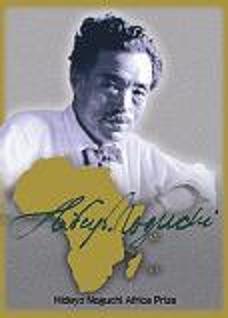
1.2 The importance of naming the Prize in his honour HIDEYO NOGUCHIAFRICAPRIZEhas deep meaning for me. Dr. Hideyo Noguchi worked in Asia, Europe, North America and South America and was given honours in many of these countries before he came to Africa. Therefore, the prize could have been named after his own country or any of the other places he had worked and received honours. Yet it was namedAFRICAPrize even though Dr. Hideyo Noguchi was in Africa for a short time and died here. I sense a deep spiritual and humanitarian message in this prize being named AFRICA PRIZE at a time when Africa was struggling with development challenges. I see a close connection in this honour that Japan bestowed to Africa and the fact that Japan was the first developed nation to bring African Heads of State together IN 1993 to discuss Africa’s development at theTokyo International Conference on African Development (TICAD). I pray that we Africans can grasp and appreciate this good will and hand of friendship and reciprocate to the extent possible.
1.3 It is wonderful that The Hideyo Noguchi Africa Prize Medical/Health Services category is unique.This is in the attention it pays to scholars, “contributing to the health and welfare” of the people and to “field-level medical/public health activities to combat diseases and advance public health” as stated in the 2007 guidelines to the nomination process. Therefore, this prize makes it possible for people to be nominated who would not have been considered in the pre-existing prizes focused on laboratory researchers and work at the molecular and sub-molecular levels. In taking this approach, the Hideyo Noguchi Africa Prize raises the importance of working on promoting universal health care that include getting health services to the marginalised. In this regard, the Hideyo Noguchi Africa Prize Medical/ Health Services created for itself a niche that promotes the right to health services for all people and makes a very important contribution in the history of accessing health services for all people.
1.4 The importance of receiving a prize is sometimes reflected in the honours the recipient of a prize is given by others. I have felt the importance of the Hideyo Noguchi Africa Prize Medical Services by the honours I have received since I became the 1st laureate of this prize. These include receiving Honorary degrees at the doctorate level from Moi University in Kenya, Ochanomizu University in Japan and from DePaul University in Chicago USA & invitation to membership of CHAMPIONS FOR HIV-FREE GENERATION which is made up of former Heads of State and other Eminent Persons active in HIV/AIDS advocacy in the period 2008 and 2011. Also in 2011, I was designated Community Health Goodwill Ambassador by Kenya’s Minister of Public Health and Sanitation. Furthermore, I was selected among the seven (7) members of the Independent Expert Review Group (iERG) that is carrying out global monitoring of accountability and performance in relation to the UN Secretary General’s Global Strategy on Women’s and Children’s Health. I feel affirmed that I was worth the Hideyo Noguchi Africa Prize.
2. INSPIRATION THAT COMES TO ME AS A LAUREATE OF THE HIDEYO NOGUCHI AFRICA PRIZE
The points mentioned under importance provide for me a deep basis from which inspiration springs. The other ways in which I have been inspired are the following:-
2.1 I very much appreciated the processthrough which information was passed to those who were to get the prizes. It was very inspiring that the Director of the Prize Unit in the Tokyo Cabinet Office, Director Tamaki Tsukada personally travelled to brief Prof Greenwood in London and then me in Nairobi. I further appreciated that in the context of this briefing, our spouses were seen as essential participants in what was to follow. The sensitivity with which this was managed was inspiring. The careful planning and keeping us informed regarding events around the Award Ceremony was inspiring. In Yokohama, we also met another officer from the Prize Unit, Ms Eri Maeda. Prior to the Award Ceremony, it was SO INSPIRING for us to be introduced to His Imperial Majesty, the Emperor of Japan and Her Imperial Majesty the Empress of Japan. Then followed the inspiring ceremony organised by the Mayor of Yokohama. We had the priviledge to see the place where young Dr. Noguchi showed his brilliance in his work including diagnosing plague on the high seas before the ship landed in Yokohama. There were inspiring ceremonies through which we were briefed and memorial stamps presented to us.
2.2. How inspiring it was at the Award Ceremony in the Queen’s Grand Ballroom in the Pan Pacific Hotellocated in the Yokohama Bay in Yokohama City! The greatest inspiration was that His Imperial Majesty the Emperor of Japan and Her Imperial Majesty the Empress graced the occasion. Also inspiring was the presence of over 40 African Heads of State who had come to attend TICAD IV. The Queen’s Grand Ballroom was full of international luminaries from the United Nations, Bilateral agencies, the Private and Public Sectors. Among them was my hero from the time I worked in the United Nations, Madame Sadako Ogata who was the President of JICA at the time. It was a great honour to be introduced to H.E. Yasuo Fukuda, the Prime Minister of Japan, to Prof Kiyoshi Kurokawa, the Chairman of the International Committee of the Hideyo Noguchi Africa Prize, and to Prof Malegapuru Makgoba the Chairman of the Africa Committee for the Hideyo Noguchi Africa Prize. I also rejoiced greatly that colleague from the institutions which had been mentioned in my citation were allowed to pay for themselves to come and witness the Award Ceremony: colleagues from the African Medical Research Foundation (AMREF); from the Kenya National AIDS Control Council and the Executive Director of UZIMA Foundation. As it turned out by chance, these three represented a continental organisation, a national organisation and a small grassroots Non Governmental Organisation! The events of the Award Ceremony were peak experiences! The moment of receiving the award from the Prime Minister of Japan, H.E Yasuo Fukuda, was electrifying with such a loud applause from the huge audience in The Queen’s Grand Ballroom. Then there was a thunderous applause as Prof Greenwood came to the end of his speech and I was ushered in to make mine, followed by a similar thunderous applause. I held up the T-Shirt that one of the UZIMA Foundation Youth, Wanene, had designed and which we took to Japan with us. The front of the T-Shirt has the words,HIDEYO NOGUCHI, AFRICA LOVES YOU. On the back are the words, JAPAN, AFRICA THANKS YOU! As I sat down, His Imperial Majesty extended his hand to touch the T-Shirt. This gave me the courage to hand it to His Imperial Majesty as a gift. His Imperial Majesty looked at it with great delight. How inspiring all this was!

African Heads of State who attended TICAD IV Meeting were present at the Award Ceremony
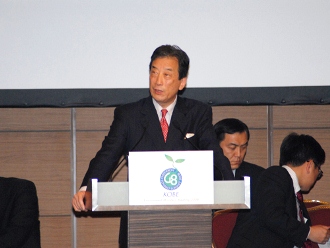
Professor Kiyoshi Kurokawa, the Chairman of the International Committee of the Hideyo Noguchi Africa Prize
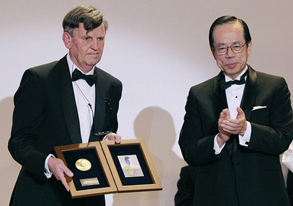
Professor Greenwood shows the award after receiving it from the Japanese Prime Minster H. E Yasuo Fukuda.
2.3. Fukushima, here we come!The day after the Award Ceremony we went to speak at the UN University in Tokyo. Professor Greenwood addressed the questionCan Malaria be Eliminated?I spoke onOpportunities for Transforming Health in Africa. From the University, we went byBullet Trainto Fukushima, the prefecture where Dr Hideyo Noguchi was born. I had been asked while in Kenya what I would most like to see in Fukushima and I had said that I would most like to meet fellow grandmothers of Fukushima. On arrival at the train station, there they were, fellow grandmothers waving the Kenya and British flags! My heart melted! That evening at the formal dinner by the Governor of Fukushima, these grandmothers were there, too. We from Africa — including Prof and Mrs. Greenwood who have lived in Africa for a long time — were provided a slot in the program to sing and, of course, to dance! And I invited the grandmothers to join us and they did! And so the Governor of Fukushima and many of the other officials joined in the day! What a way of ending the day in Fukushima dancing to an African beat! The leaders and people of Fukushima received us with so much warmth and joy!
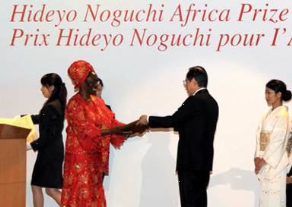
1st awarding of the HIDEYO NOGUCHI AFRICA PRIZE in Japan on 28th May 2008 by the Prime Minister of Japan H. E Yasuo Fukuda.
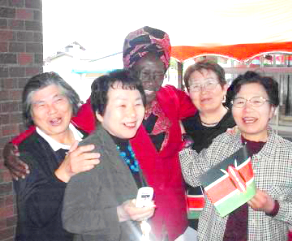
Miriam Were with Fukushima grandmothers, like herself, who she requested to meet on the visit to Noguchi’s birthplace in Fukushima. They came to meet the bullet train on arrival.
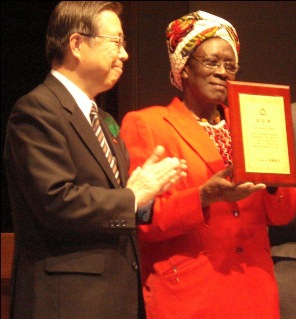
HON. YUHEI SATO, Governor, Fukushima Prefecture bestowed on Miriam K. Were and Brian Greenwood Honorary Goodwill Ambassador of Fukushima.
This was in the midst of a fantastic program in Fukushima organized by the Governor’s office and that of ICHIRO TAKAZOE: DDS, PhD President, The Hideyo Noguchi Memorial Association.
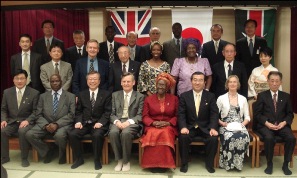
Both laureates pose for a photo with officials from Fukushima, family and other invited VIPs from Fukushima & Tokyo
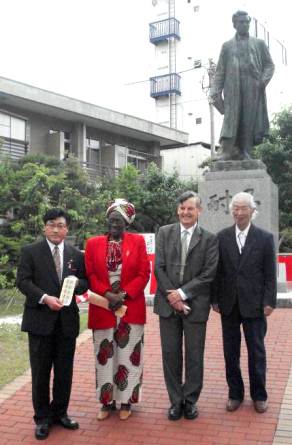
The Laureates arrive at the Hideyo Noguchi Monument in Fukushima, where they laid flowers.
Among the events in Fukushima was a visit to the Hideyo Noguchi Memorial Hall. We saw a house similar to the one where Dr Noguchi had lived as a child. It had a fireplace similar to the one young Noguchi had fallen into which resulted in his deformed left hand.
We saw the objectives for his life which young Noguchi wrote by curving Japanese characters into a piece of wood when he left home for Tokyo. We saw his clothes and his light microscope with which he had conquered the world of microbes. As I stood there, overwhelmed with how Dr. Noguchi achieved so much with the simple microscope, I felt a presence close to me. I thought it was one of those with whom we had come to the museum. But when I looked no one was next to me. Then I sensed the presence of Dr. Hideyo Noguchi himself and saw his face clearly which had a smile on it. He remained with me during the entire tour of the memorial hall. We also visited the Noguchi Monument in Fukushima where we found school boys and girls reciting poems and singing praises in his honour. Many flower banquets were at the foot of the monument. Professor Greenwood and I also placed flowers at the foot of Hideyo Noguchi monument in honour of Dr Hideyo Noguchi.
We also spoke at the Aizu University. My speech was entitled FROM PUBLIC TOILETS TO HEALTH CLINICS. Some of the Fukushima officials had read about my work and knew the campaign I had lead on construction and use of latrines as a strategy to cut down waterborne diseases and worms transmitted from contaminated soil. So they sent this title through the Cabinet office to me while still in Kenya and asked that I speak on it. And so I did! During our Fukushima visit we sampled traditional Japanese culture of having hot steam in your room, sleeping on a mat, drinking sake, and experiencing the Japanese Tea Ceremony. Joyful memories from Fukushima continue to linger! What an inspiration the whole experience was!! So when, in 2011 Fukushima was one of the areas hit by the earthquake, tsunami and nuclear disaster, I felt that I should at least get back to Fukushima and while standing on the soil of Fukushima say a prayer for those who were alive but hurting; for the spirits of those known to have died and those still unaccounted for. Using my frequent Flier Miles, and assistance from colleagues in Japan under the leadership of the Director of the Prize Unit in the Cabinet office, Mr. Toshihiko Horiuchi and my colleague and friend, Akemi Bando, it was possible for me to travel to Fukushima in October, 2011.
We visited the Hideyo Noguchi Memorial Hall and found the same officials there. I went to the sea that had risen in tsunami and prayerfully, I threw a banquet of flowers into the sea in memory of those lost at sea. I visited a hospital, a school and temporary homes for the displaced. My spirit was in prayer in all these places. The brave people of Fukushima were hurting but still smiling. I returned to Kenya with a more rested spirit. While on that trip, I also visited key offices in Tokyo including the offices of the NGO HANDS, Mr. Yasuhiro SONODA, Parliamentary Vice-Ministers of Cabinet Office, Government of Japan, Dr. Makoto MUGITANI, Assistant Minister, Ministry of Health, Labor and Welfare, Dr. Kiyoshi KUROKAWA, Professor of the National Graduate Institute for Policy Studies, Dr. Keizo TAKEMI Professor, Tokai University with whom I shared a T-Shirt I printed and brought with me in the KIZUNA spirit.
Visit to Fukushima after the Earthquake, Tsunami & Nuclear Accident with Director Toshihiko Horiuchi of the Prize Unit in the Cabinet Office & Ms Akemi Bando of Osaka University
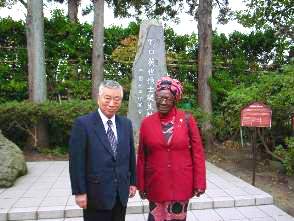
Prof. Were together with Mr. Yasuo YAGO, the Director of Hideyo Noguchi Memorial Hall
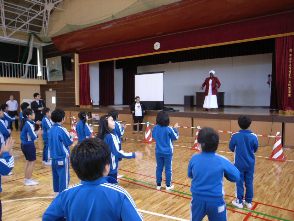
Prof. Were gave a lecture on African culture to children of Nakamura Daiichi Elementary School.
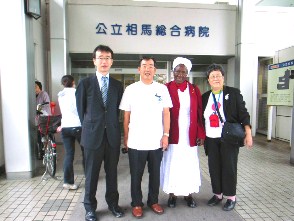
During her visit to Fukushima in October, 2011.
Prof. Were with Director Toshihiko Horiuchi of the Prize Unit, the Director of Soma Public hospital Dr Yoshinobu KUMA MD. PhD and Ms Akemi Bando of Osaka University
4 The prize was welcomed home with song and dance straight to breakfast in one of Nairobi’s leading hotels. The breakfast was attended by the Japanese Ambassador, by Government officials, colleagues from organizations named in my citation and family. Song and dance lasted all day. This, too, was inspiring!!!
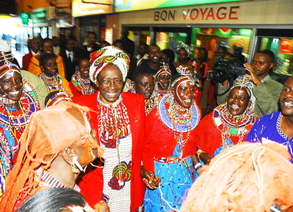
Welcome song & dances with family, colleagues & traditional dancers from several communities in Kenya: Masaai, Kamba, Kikuyu and Luhya which is Miriam’s community
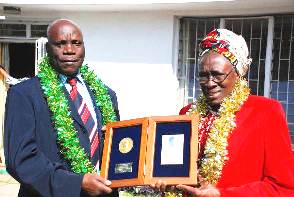
Humphreys and Miriam Were garlanded by the joyful people receiving them with the HIDEYO NOGUCHI AFRICA PRIZE
3. CONTRIBUTION OF THE PRIZE TO MY PROFESSIONAL WORK
Through the world-wide recognition that the prize brought to me as well as the prize money, opportunities opened wider in the professional areas of my focus. I will refer to three of them.
3.1 Opportunities to improve health care services for Mothers and Children through the MCH Handbookis one key areas that the prize widened for me. All my life I have been concerned with MCH Services because in most African countries, 75% of health services are for mothers and children and yet so many of them still remain unreached. I will be detailed in the section that follows because it illustrates how one thing leads to another in a way that to me communicates divine coordination.
Following the Award ceremony in May, 2008, in June I was in New York for the UN Special Session on HIV/AIDS in my capacity as Chair of the National AIDS Control Council. While in the crowds at the UN HQ, two Japanese women came to me with big smiles. They said they had seen me on Television in Japan at the time of the first Award of the Prize and that they were in New York in the Japanese delegation and that they worked on tuberculosis (TB). The next day they informed me that they had told the Japanese Ambassador to the UN about me being in New York and asked me to see him. I made an appointment for the office the next day. During our talk, the issue of the impact of HIV/AIDS on mothers and children came up. The Ambassador asked me if we in Africa use the Mothers’ Handbook which had originated in Japan and was now used in Indonesia and other Asian countries. I was not aware of a book by that name. By the time I got back to Kenya, a member of his office had sent me web-based information on this. Then in 2009, I was invited to give lectures at Nagasaki University in Japan. On my way back, I attended a symposium at Osaka University on Health in Africa and the issue of the Mothers’ Handbook came up. Pretty soon, under the Leadership of Prof Y. Nakamura, I had a lot of information on the Mothers handbook referred to a MCH Handbook. I could see many ways in which having a combined record for the mother and child could be of help to African families. Instead of mothers worrying about several cards for themselves and for each child, they would have only one record that covers pregnancy, newborn right up to the child is five years of age.
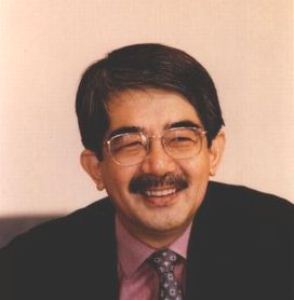
Prof Yasuhide Nakamura of Osaka University
I saw this as an excellent way to ensure the provision of continuumof care: antenatal care for pregnant women- delivery & newborn care-postnatal care including family planning-child care up to five years of age. At each stage the MCH Handbook spells out what care to give. The family keeps the book very much like they do the Child Welfare Card and so could take it wherever they go and get care that is recorded in the child’s MCH Handbook. Having such combined records would also facilitate coordination of MCH services. By the time I left Osaka, Prof Nakamura and his team had promised to assist me organise a workshop for Eastern Africa countries on the MCH Handbook. That workshop was held in March 2010 and a Framework was developed on how to go about developing the MCH Handbook in each country. Some of the funding that made this possible came from the prize money I received. Since then, Uganda has developed its MCH Handbook and thus Kenya and Uganda have national MCH Handbooks. Right now the process is on for organising the 8th International Conference on MCH Handbook to be hosted by Kenya to which most African countries are invited. A strong contingent from Japan will be attending this conference to present keynote speeches and to facilitate. I believe that this is a mile stone in improving MCH Services in Africa and an opportunity to accelerate progress towards meeting Millenium Development Goals (MDGs) 4 & 5. All these activities and my membership in the Global Health Workforce Alliance (GHWA) resulted in me being one of the seven (7) in the Independent Expert Review Group (iERG) of the UN Secretary’s Global Strategy on Every Woman and Every Child’s Health.
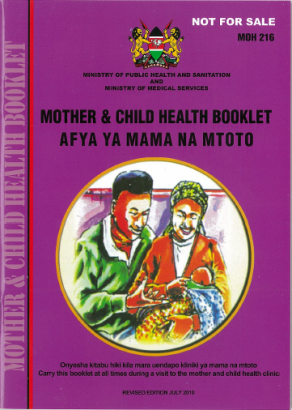
Kenya's MCH Handbook
3.2 Involvement in Promoting Community Health in the Context of Health Systems Strengthening:
One of the major outcomes to the G8 Meeting of 2008 in Japan was a focus on Health Systems Strengthening. The TAKEMI working Group that came out of that meeting held a consultation in Tokyo in November, 2008 to which I was invited. In April 2009, the Africa Seminar on the subject was held at AMREF in Nairobi under the guidance of the Japan Centre fir International Exchange. Further involvement in this line took place on the project by the Kenya health sector on strengthening health management in one of Kenya’s region, Nyanza. Dr Sugishita Tomohiko invited me to speak at some Seminars and I also got to see the work of the Project on MINDSET CHANGE. In these seminars, my focus was on the importance of having strong community level health services and why since establishing effective Community level health services has been the main focus of my professional work. Recognition that came from this prize strengthened my working relationship with the Ministry of Public Health and Sanitation. During 2010, I was the Consultant to the Ministry in the organisation of the1st National Convention on Community Health Servicesthat reviewed the work of the Community Health Strategy. That convention was very successful and motivated health workers to guiding and implementing Kenya’s Community Health Strategy.
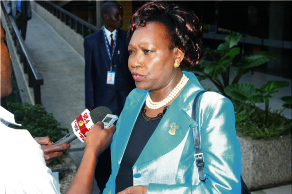
Hon. Beth Mugo, Minister of Public Health & Sanitation being interviewed after presenting the opening speech during 1st National Convention on Community Health Services held in Nairobi, Kenya
In May, 2011,The Minister of Public Health and Sanitation of Kenya designated me Community Health Strategy Goodwill Ambassador. Since then I have worked with the Ministry in developing Curriculum and Trainers Manual for Community Health Committees. In April 2012 in Addis Ababa, Ethiopia, I coordinated the presentation of Ethiopia, Ghana, Kenya and Malawi on Community level Health servicesduring the World Congress of the World Federation of Public Health Associations.In June, 2012, I was the Resource Person to the Africa-wide Regional Meeting held in Addis Ababa on Community Health Workers. As a Board Member of the Global Health Workforce Alliance (GHWA), I am requested to review programs and proposals that deal with Community level health services. In my professional judgment, the adoption of the Community Health Strategy by African countries accelerates Universal Access to health care and improves health status. Emerging evidence is pointing to this in several countries including Ethiopia, Ghana, Kenya, Malawi, Rwanda and Zambia.
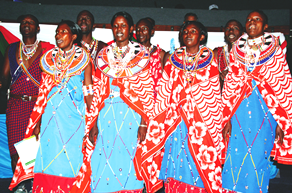
Community Health Workers from Masaailand at the convention in their traditional costumes
I appreciate that requests for my involvement in matters of the community approach to development is being sought widely including the application of the Community-based approach to the control and management of HIV/AIDS and appreciate the prize’s contribution to this. People trapped in a huge burden of disease cannot bring about the massive development that Africa needs. It is still very clear to me that the way to reduce the disease burden, enhance human development and the quality of life for us in Africa is through multi-sectoral Community-Based Health approaches in both rural and urban slums in our cities. I am delighted that the Kenya Community Health Strategy is becoming successful in working with both rural communities and with communities in urban slums.
3.3 Working on Youth Empowerment that includes promoting their Healthhas been a preoccupation of my husband, Humphreys R. Were and I most of our lives. This culminated in registering UZIMA Foundation in Kenya in October, 1995 working together with friends and extended family members
We were amazed by the huge demand for what UZIMA Foundation offered youth in early 1996. Supported the work from our salaries and savings, we realized UZIMA having its own training center would cut down cost of hiring places to train the youth as this was the largest expenditure. So we took a bank loan in 1997 and bought 6 acres of land close to Nairobi build theUZIMA Training Centre.
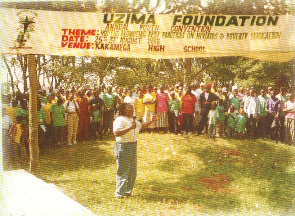
UZIMA Youth at the 2001 convention being addressed by the then Executive Director,
Ms Malesi K. Kinaro
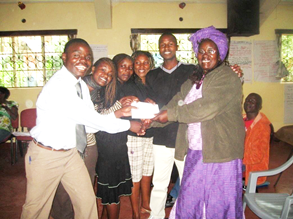
A group applying for membership in UZIMA Foundation from the inaugural Director Ms Malesi Kinaro
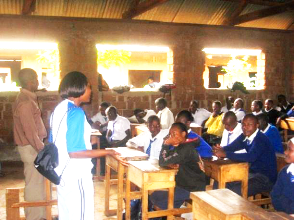
UZIMA Youth in a session on control of HIV/AIDS
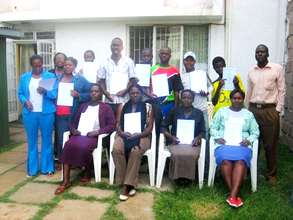
UZIMA Youth with certificates after training in business skills
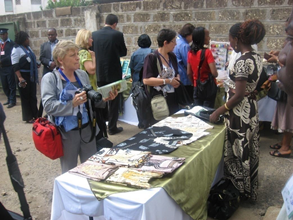
UZIMA Youth sell their Handcrafts to international visitors in Nairobi
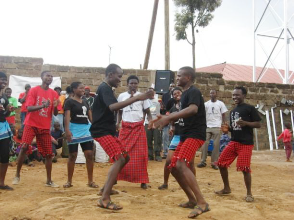
UZIMA Youth in dance session in the program of Safe and Clean Fun
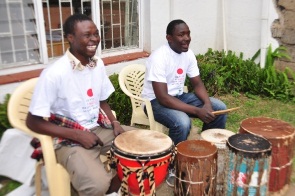
UZIMA Youth use song and dance to overcome many tragedies in their lives sent this message to Japanese youth after the 2011 tragedies
In view of the successes that UZIMA Foundation was having in many areas in the lives of the youth UZIMA’s Founders (Mama Miriam & Papa Were) approached donors with requests to work with us on building the centre. The reply was that before this could be discussed, we needed to have professionally done architectural designs. In discussion with architects we discovered that it was very costly to do this. So nothing happened to the land for over 10 years as the land is in the dry area of the Masaai where farming is not easy.
When I received the prize money in 2008, some of it immediately went into commissioning an architect to work on designs. He in turn put together a team consisting of a Structural Engineer, Hydrological Engineer, Quantity Surveyor and himself, the architect. The professional designs were completed in 2009 with an estimated cost at the time of US$ 3m. It so happened that by 2009, the world was gripped by the financial crisis. So when we took UZIMA Training Centre designs to those who had asked us for them, they stated there were financially unable to be involved. So nothing is happening regarding building. However, with the designs completed, a water project proposal was prepared so that there would be water on the land in preparation for the time building would take place and to also make water available to the community since women travelled some miles to fetch water for domestic use. This proposal was accepted by the Office of the Ambassador of Japan in Kenya in the Grassroot Grant Program (GGP) through which a borehole was drilled. Funds for piping and storage tanks came from the prize money I had received. This water is already benefitting the community near the land as a kiosk was developed at one end of the plot from which the community fetch water for family consumption and to also bring their animals to drink from the trough built into the design. Furthermore, the Executive Director of UZIMA Foundation is experimenting use of the water for irrigation to see if the land can be a viable producer of vegetables to sell as a source of funds to UZIMA. However, our prayers are focused on getting the UZIMA Training Center built as the need is even greater now and a feasibility study on long term sustainability has shown once established and supported for the initial period, the centre will be able to sustain itself. In the meantime, there is water to be used in the construction process when it starts!
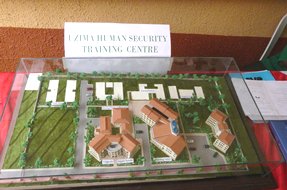
Model of UZIMA Human Security Training Centre that we hope it will be possible to build. Professional design developed with funds from the Hideyo Noguchi Africa prize to Mama Miriam. In it is to be the HIDEYO NOGUCHI – JAPAN House
Another aspect of support to youth to which the prize money has contributed significantly is for payment of fees for girls who have managed to complete High School but find themselves helpless as they are AIDS Orphans or destitute in other ways. Support has come to them through fees payment for 10 of them to be trained to become Preschool Teachers, 2 of them to become nurses. Fees has also and training at University. Most of the girls assisted had no mean of support other than prostitution. Fees has also been paid for 2 male AIDS orphans who are brothers; the older one for a computer design course towards making his work in publishing more viable and the younger brother for training in Project management at the Certificate and Diploma level. Other youth have been assisted to complete their high school education when stranded half way as couldn’t manage the rest and also University fees. Most of the beneficiaries have been identified from UZIMA Youth activities.
4. ANNUAL CELEBRATION OF THE PRIZE
One of the unique features of the Hideyo Noguchi Africa Prize is that so far, the frequency of awarding both the prize for Medical Research and that of Medical Services is every five years. I have sensed that this prize could be “lost” from the public since prizes at this level like the Nobel Prize are given annually and in numerous categories. It seems to me that given the five year interval, it is necessary for the prize to go with institutionalizing annual anniversary celebrations. As this arrangement is yet to be institutionalized, I decided to devote event each year as an anniversary of the prize. The 1st Anniversary Celebration was the most “flamboyant” one on which I spent some of the prize money and which also received support from offices of the Ambassadors of Japan in Kenya and that of the JICA Chief Representative. I sponsored the publication of the report from that 1st anniversary entitled SPREADING THE NOGUCHI SPIRIT OF SERVICE TO HUMANITY.
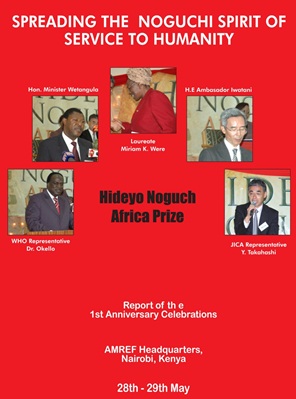
The Government of Japan sponsored the HIDEYO NOGUCHI AFRICA PRIZE MEMORIAL SYMPOSIUM in Accra, Ghana in 201o. I identified my participation in this to mark my second anniversary celebration of the prize. The occasion was graced by HIS IMPERIAL HIGHNESS THE CROWN PRINCE OF JAPAN who addressed the symposium. Others who addressed the symposium were the current President of Ghana, H.E Mahama when he was Vice President as well as the Chairman of the Prize Committee, Prof Kiyoshi Kurokawa. Both Prof Greenwood and I also addressed the symposium. My involvement was in the preparation and delivery of a lecture entitled TOWARDS A VIBRANT AFRICA: WITH HEALTHY MOTHERS AND CHILDREN IN SUB-SAHARA AFRICA. Furthermore, I decided to use that opportunity to share with the Ghanaian audience the LIFE STORY OF HIDEYO NOGUCHI through the Kamishibai method. Therefore, I sponsored the travel and related costs for the duration of the stay of two youth from UZIMA Foundation who presented the KAMISHIBAI in Accra, Ghana.
Notable in this period was to make contact with Japanese Ambassador in countries where I was going to be of professional work. Thus I paid courtesy to the Ambassadors of Japan in Ethiopia and Senegal. The Ambassadors in both of those arranged an event at which I met leading citizens of those countries and talked about the prize. I also contributed t the preparation and success of the 1st National Convention on Community Health Services as mentioned above under contributions the prize has made to my work. JICA was one of the key supporters of this convention and I had the privilege to work with Ms Makiko Kinoshita who was a JICA Expert based in the Ministry of Public Health & Sanitation.
For the 3rd anniversary, in 2011,the year in which Kenya’s Minster of Health and Sanitation designated theCommunity Health Strategy Goodwill Ambassador, I focused, in the first part on working on how to increase the effectiveness and also the expansion of the Community Health Strategy approach not only in Kenya but also across Africa. One of the outcomes was that I wrote a paper entitledEFFECTIVE COMMUNITY HEALTH: THE NEXT BIG WAVE FOR VIBRANT AFRICA. This title was agreed upon with the JICA Chief Representative in Kenya at the time. It so happened that I was invited to Japan by the Japan Society of Volunteers in a symposium marking ten years of the International Year of Volunteers which was observed in 2001. During that visit, I had the privilege to visit the President of JICA and address the JICA staff. With the JICA President, I shared that the paper as above could be the topic of discussion during TICAD V. I have not heard feedback on this but I have pursued the ideas through participation as International Conference for Sexually Transmitted diseases in Africa (ICASA) in December, 2011. I also shared these ideas at the World Congress of the World Federation of Public Health Associations which was held in Africa in early 2012. It has been very gratifying to see that the number of African countries adopting this approach is increasing. Now this includes Ethiopia, Ghana, Kenya, Malawi, Rwanda and Zambia among others.
The 4th anniversary, in 2012, of the HIDEYO NOGUCHI AFRICA PRIZE coincides with the 8th international Conference on the MCH Handbook being held in Africa for the first time hosted by Kenya in Nairobi. Among those coming for this event are Prof Nakamura of Osaka University in Japan and the Director of the Prize Unit of the Cabinet Office in Tokyo, Toshihiko Horiuchi. Professor Kiyoshi Kurokawa, the Chairman of the International Committee of the Hideyo Noguchi Africa Prize will give a key note address on the first day. In his speech, he will address both the Japanese policy on Global Health and the Hideyo Noguchi Africa Prize. He will also be present at the 4TH Anniversary event to be held on the evening of the second day on the conference. This will provide an opportunity to familiarize a large audience from Africa on the Hideyo Noguchi Africa Prize.
So as we come to the close of the 5th year in 2013 when the 2nd group of prize winners will be selected, I feel very joyful that in the last four years, I have been spreading the message on Dr. Hideyo Noguchi and about his spirit of Service to Humanity.
5. IT IS IMPORTANT TO MAKE DR HIDEYO NOGUCHI KNOWN THROUGH OUT AFRICA.
5.1.Making KAMISHIBAI on Dr. Noguchi’s life story an Africa-wide project. As stated in the first point, the achievements of Dr. Hideyo Noguchi are impressive. Now that there is a prize named HIDEYO NOGUCHI AFRICA PRIZE, it seems to me very necessary to do everything possible to make Dr Hideyo Noguchi know by the majority of the people of Africa; especially the youth. So we worked with JICA office in Nairobi and they helped us to get the LIFE STORY OF DR. HIDEYO NOGUCHI in KAMISHIBAI format. Whenever UZIMA Youth use it to tell the story, African youth get very inspired. They can see that he did not come from a wealthy family. They can see that he struggled with disability. And many of them can identify with one aspect of his life or another. Dr. Noguchi’s life provides two basis for challenging people in Africa. One is that of rising above your difficulties and performing well. This is a great challenge to most youth. The other challenge is to people who have jobs and who get a salary. They need to think of how to financially support the more needy ones just as Dr. Hideyo Noguchi was supported. So there is need to think about how to make this KAMISHIBAI an Africa-wide project.
5.2.Writing a biography of Dr. Hideyo Noguchi from an African perspective so high school and University youth have access to it. On the same basis as 4.1 above, I think this should be done. It is one way of promoting the Spirit of Dr. Hideyo Noguchi of SERVICE TO HUMANITY!
THANK YOU FOR YOUR KIND ATTENTION.
Miriam K. Were
Hideyo Noguchi Africa Prize 1st Laureate, Medical Services
